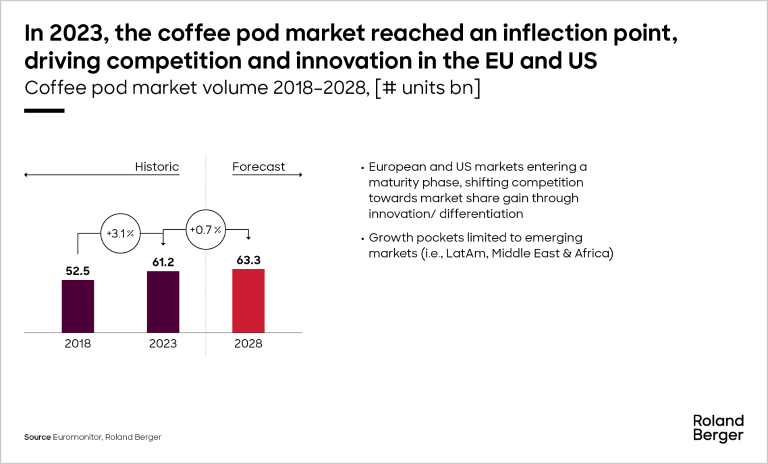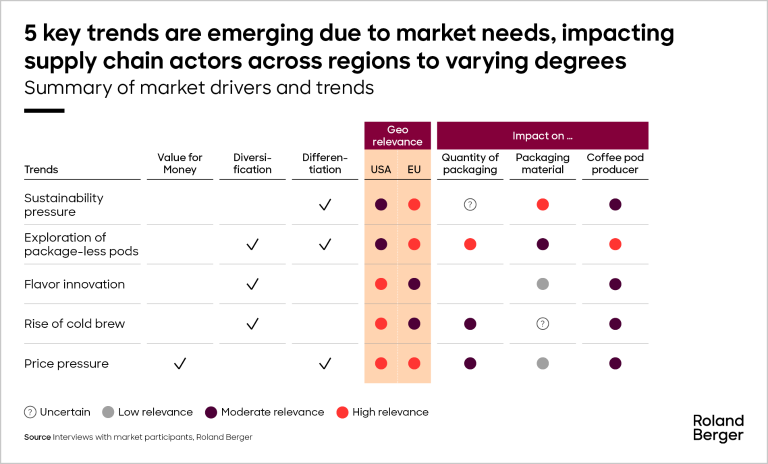Supporting packaging companies, converters and equipment providers to navigate the rapidly changing packaging and processing market.


The future of coffee pods
How the industry is responding to a new era of consumer needs
In the wake of 2023, the coffee pod market reached an inflection point, signaling a pivotal shift in consumer preferences and market dynamics. This article delves into the intricate tapestry of the coffee pod industry, exploring the nuances of market share gains, consumer needs, and the burgeoning trends shaping the future of coffee consumption.

"The coffee pod industry stands at the forefront of innovation, where each advancement is not just a step towards better products, but a leap towards a more sustainable future."
Innovation and Differentiation: The New Market Drivers
The year 2023 marked a watershed moment for the coffee pod market, as traditional growth strategies gave way to innovation and differentiation. Emerging markets, once fertile grounds for expansion, now present limited opportunities, compelling companies to pivot towards creating unique offerings that resonate with discerning consumers.
Affordability and Diversification: The Post-Pandemic Consumer Psyche
The post-pandemic era has ushered in a heightened economic consciousness among consumers. Affordability no longer remains a mere preference but a necessity. The market has responded with a diverse array of products, catering to the varied palates and wallets of coffee enthusiasts. This shift underscores the importance of diversification in a market where one size does not fit all.
Five Key Trends Percolating Through the Market
- Package-less Pods: In a bid to reduce waste, the industry is exploring package-less options, offering consumers a guilt-free coffee experience.
- Flavor Innovation: The quest for new and exotic flavors is on the rise, with companies experimenting with blends that promise to tantalize the taste buds.
- The Rise of Cold Brew: Cold brew coffee continues to gain popularity, appealing to those who prefer a smoother, less acidic cup.
- Price Pressure: With the cost of living on the rise, consumers are increasingly price-sensitive, prompting companies to find a balance between quality and affordability.
- Sustainability Pressure: The call for sustainable practices is louder than ever, with consumers and regulators pushing for eco-friendly alternatives.
"Amidst an evolving landscape, the coffee pod market's future is anchored in our collective ability to embrace change, innovate sustainably, and meet the new era of consumer expectations."
The trends mentioned above are not uniform across the globe. Regional preferences and regulations play a significant role in shaping the market. For instance, the demand for compostable pods may be higher in regions with stringent waste management laws. These variations have a ripple effect on supply chain actors, who must adapt to the evolving demands of the market.
Sustainable Solutions
As the industry gravitates towards sustainability, compostable and capsule-free coffee products are becoming the norm. The development of compostable bio-based packaging and the elimination of plastic and aluminum from coffee pods are testament to the industry's commitment to the environment.
The Balancing Act: Differentiation vs. Economic Competitiveness
One of the greatest challenges facing coffee pod players is the delicate balance between innovation and cost competitiveness. The market demands differentiation, but not at the expense of affordability. Timely investments in innovation are crucial, as is the ability to offer diversification at attractive prices.
Adapting to Maturity-Driven Dynamics
The coffee pod industry is at a crossroads, with maturity-driven dynamics dictating the need for change. Players along the supply chain must rethink their strategies, from the sourcing of natural packaging materials to the adoption of new supply chain models. The future of the coffee pod market hinges on the industry's ability to adapt, innovate, and satisfy the evolving tastes and values of consumers.
As Roland Berger, we identified five cornerstones to deal with ongoing coffee pod industry maturity-driven changes:
Focus on core capabilities
- Search for market adjacencies addressable via existing capabilities
- Ensure clear understanding of link between opportunities and capabilities
Actively manage complexity and portfolio
- Apply a disciplined approach to innovation, limiting proliferation
- Optimize cost structure on existing business, evaluating selective divestments
Partner up and share development risk
- Establish vertical joint development both upstream and downstream
- Ensure right incentive systems are in place for the mid/ long term
Address operating model requirements
- Evaluate impacts on self and partners’ operating model and required changes
- Develop phased roadmap to avoid short term disruption
Establish execution discipline
- Ensure innovation and cost optimization accountabilities are cascaded through the organization
- Set priorities and timelines aligned with mid-long term perspective











